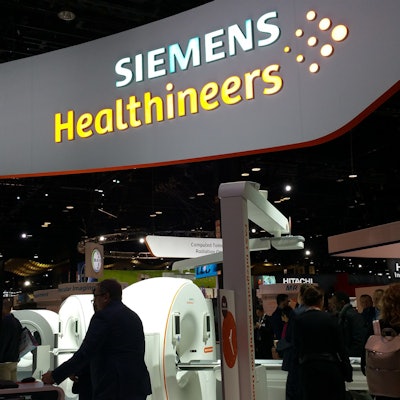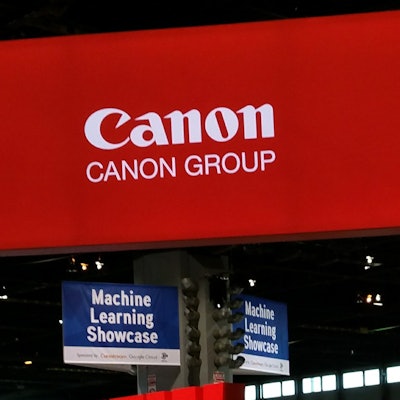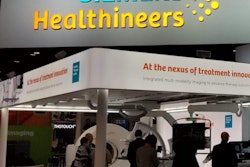
At the start of the year, we offered a discussion on how 2018 would be a landmark year for four of the leading vendors in medical technology: GE Healthcare, Siemens Healthineers, Canon Medical Systems, and Philips Healthcare. Ahead of the next round of quarterly results due in the coming weeks, we offer a progress report, reviewing their performance to date, updated strategies, and likely outlook for the rest of 2018 and beyond.
GE Healthcare: Consistency amidst parental turmoil
- Solid first-half 2018 results, realizing continued sales growth (9% in Q1 2018, 6% in Q2 2018); profitability has remained in line with 2016 and 2017 at 17% to 18%
- Abrupt removal of GE CEO John Flannery has sparked new uncertainty over spin-off of healthcare business unit into separate entity
- Strong results in medical imaging business, especially in emerging healthcare markets
- Life sciences area continues to be a growing focus for GE in a bid to position itself as a "precision medicine" vendor; recent agreement with Roche Diagnostics is significant
The Signify take

Despite the recent unexpected replacement of GE corporate CEO John Flannery, the GE Healthcare business unit continued its impressive, consistent run of revenue growth and steady improvement in profitability. Moreover, GE Healthcare has appeared more focused in its overall strategy and market positioning of late, homing in on its core medical imaging, clinical, and life sciences units and the theme of precision medicine. This also included the sell-off of its value-based care unit to Veritas Capital.
The business has also benefited from improved economic performance in 2017 and the first half of 2018 in emerging markets, where it has invested heavily in a "in-region, for-region" strategy, which now appears to be paying off handsomely with a strong order book despite slowing in more mature markets. However, reports continue to suggest that GE is struggling in imaging informatics, a hangover from interoperability issues between legacy solutions and new product launches.
That said, GE has progressed in broader clinical informatics, especially with growing momentum for its "clinical command center" analytics, a play that well suits its increasingly focused approach to value-based care and precision medicine. Its recently announced partnership with Roche Diagnostics, a leading life sciences vendor, is also a welcome change in tack, suggesting GE Healthcare today is more open to partnership, rather than its previous acquisition-heavy strategy.
Outlook
GE will remain a significant and strong player across diagnostics and clinical sectors, though weakening economic performance expected from emerging markets could impact its ability to maintain its current rate of growth in the short term. However, uncertainty as to the future of the unit with a new CEO will continue to overshadow the business for the rest of the year, and significant work is required to turn around the slide in imaging informatics.
Siemens Healthineers: Smooth IPO but future growth questions remain
- Initial public offering (IPO) smoothly completed with little obvious impact on Healthineers business results
- Revenue growth of business unit in first half of 2018 remains on track for 3% to 4% growth for full year, though currency challenges affected business
- Medical imaging remains the core driver of growth, with limited contribution from the diagnostics or advanced therapies divisions in 2018
- China is one of the strongest growth markets for Siemens Healthineers, with currency-adjusted growth of 9% for Siemens fiscal Q1 to Q3 (October 2017 to June 2018)
The Signify take

The steady performance of Siemens Healthineers so far in 2018, despite the IPO, is certainly a positive. Its radiology business remains the core growth engine, with business in line with its peers in mature North American and Western European markets and strong growth in China. Siemens also continues to invest in R&D to maintain its strong technical reputation for imaging, exemplified by the arrival of flagship product announcements in both PET/CT and ultrasound this year.
However, questions remain over Siemens Healthineers' ability to find new growth markets to supplement the performance of its medical imaging division. While the IPO should enable the business to more aggressively pursue acquisitions and partnerships, there has been little evidence of this so far, meaning it still has significant portfolio gaps to fill in comparison to GE and Philips.
Siemens has also offered a less coherent strategy to date in addressing value-based care and precision medicine, a challenge it will continue to face without filling portfolio gaps. The imaging business has also been less aggressive in transitioning its customers to operational purchasing models; this will become increasingly important as providers look for a partner for longer-term, risk-sharing agreements to meet value-based care initiatives, especially in mature markets where Siemens has a significant presence.
Outlook
Overall, the Siemens Healthineers business continues to perform reasonably well, matching the profit margins of its peers, though with slightly less positive revenue growth in 2018 so far. While it continues to maintain its position as a leader in technical excellence for radiology and medical imaging, further progress is needed in broader clinical care and clinical informatics to compete for the most lucrative health provider deals.
Siemens has sensibly kept close ties with Cerner, one of the two dominant electronic health record (EHR) vendors in North America, and this should provide a springboard for it to establish and develop products and solutions to address customer needs outside of its core diagnostic imaging business. That said, it has some catching up to do to match the offerings of Philips Healthcare and GE Healthcare today.
Canon Medical Systems: A step in the right direction, but broader clinical traction will be tough
- Medical business slightly down in the first half of 2018 in comparison to the first half of 2017, though 2017 results described as "particularly strong"; weak Japanese market has also affected revenues, down 15% in the first half of 2018
- International sales have offset some first-half 2018 challenges in Japan, with strong results in Europe and Asia Pacific (excluding Japan); North America has been flat in comparison
- Some progress has been made in health informatics, with a rebranded Vitrea modular platform now offered, including coverage across advanced visualization, viewing, clinical archiving, and business analytics
- 2018 revenue guidance for Canon Medical business revised down after Q2 2018 results
The Signify take

Overall, Canon has had a reasonable performance so far when considering the scale of integration required following its acquisition of Toshiba Medical. It has quickly done away with legacy brands (in most cases, though Vital Images remains an active brand in North America) and focused on branding all products under Canon Medical. This is also notable in its rebranding of its legacy health informatics brands into a more consistent "platform" under the well-known and respected Vitrea product branding.
However, while it has continued to see strong success in Europe for medical imaging, a market many of its peers have struggled with, the overall outlook for the rest of 2018 is less positive. Its exposure to the declining Japanese market and a lack of growth in North America in the first half of 2018 has forced a downward revision for its overall business. It is also operating at a slightly lower profit margin of 15% compared to its peers discussed here.
Progress with informatics has also been sluggish; while the rebranding is a step in the right direction, we have observed few examples of new business being generated in enterprise imaging IT outside of its core advanced visualization market and customer base, suggesting it remains a niche player here. Moreover, Canon Medical has also made little progress in addressing the need for broader clinical IT solutions outside of radiology, thereby limiting opportunities for winning new customers in the future.
Outlook
Some progress with more coherent branding and marketing will help build the Canon brand as a significant competitor. However, little progress has been made to expand outside of medical imaging, likely due to the challenges of integrating the complex network of legacy businesses into Canon.
The company's exposure to the Japanese market and relatively limited emerging market business for medical imaging could also limit its future growth prospects in comparison to its peers, while a flat performance in the first half of 2018 in North America suggests it has a lot more work to do in winning customers in advanced imaging modalities and enterprise imaging.
Philips Healthcare: Comfortable with the long game
- Solid performance in first half of 2018 and remains on track to meet 4% to 6% revenue growth guidance for 2018; first-half 2018 order book well up against 2017 across regions
- Healthcare division has continued to make additional acquisitions in targeted strength markets, most notably in image-guided treatments
- Overall healthcare business has continued to transition to subscription-based customer engagements, with almost 30% of revenue now "recurring"
- Diagnosis and treatment business (predominantly medical imaging and clinical care hardware) is the strongest performing segment in 2018 so far
The Signify take

Overall, Philips has had a strong start to 2018, exemplified by the upward trend in its order book over the first half of 2018. Like GE, it has capitalized on its strong position in medical imaging and clinical care hardware and informatics, and it continues to pursue a strategy focused on long-term partnerships across a range of clinical sectors.
However, Philips' strategy markedly differs from that of GE Healthcare in its breadth of focus. While GE has slimmed down to concentrate on its core medical imaging, clinical care, and life sciences divisions, Philips has actively expanded its focus, most notably in wider promotion of its own EHR solution, previously only available in Latin America, and in ongoing investment in market creation for digital pathology. Today, Philips has product reach across a broad clinical sector, including diagnostic imaging, clinical care, digital pathology, electronic medical records, population health, and personal health (consumer).
Philips' core aim with this strategy is to win large, long-term partnership deals with the largest health systems and providers, offering an "all-you-can-eat" approach. It is also actively pushing subscription-based business models and risk-sharing contracting, a relatively new concept for our traditionally capital-intensive healthcare sector.
However, pursuing this strategy does have its challenges and costs; large, complex long-term deals based on managed services or risk-sharing models commonly have long lead times (many years) for procurement, especially when involving public health governance, and sometimes are taken on as a loss-leader for the initial term of the deal. While this allows Philips to essentially lock out its competition, it also puts significant pressure on the upsell of further services and products over the contract term, as well as requiring ongoing investment in professional services resources to ensure risk-sharing outcomes are met to keep the deal profitable.
All of this can eat away at margins. Today, Philips Healthcare's profit margin is in line with its peers, but some may query whether its longer-term focus is affecting its ability to capitalize on the perceived weakness of some of its largest competitors in the market today.
Outlook
Looking ahead, we expect to see Philips ease back a little on broadening its reach further into new product segments and focus more on execution and depth within its current portfolio. Questions also remain over the ability of Philips to integrate the various products and services of its broad portfolio into a seamlessly interfaced platform, with many of its strategies for a combined clinical "ecosystem" outlined as a work-in-progress.
 Stephen Holloway.
Stephen Holloway.That said, beneath the marketing, it is also actively targeting regional markets with different selections of its product portfolio, enabling it to adapt better to fit with incumbents and localized market conditions, a benefit of having breadth of portfolio. There has, however, also been little discussion from the firm on the role of life sciences within precision medicine or on how the firm plans to address this gap in its coverage, either through further acquisition or partnership.
So, while Philips is playing the patient "long game" in terms of winning large customers, it must also be more forward in outlining how it will address the future convergence of in vivo and in vitro diagnostics -- or risk being overtaken by its competition.
Stephen Holloway is principal analyst and company director at Signify Research, a health tech, market-intelligence firm based in Cranfield, U.K. He can be reached at [email protected].
The comments and observations expressed do not necessarily reflect the opinions of AuntMinnie.com, nor should they be construed as an endorsement or admonishment of any particular vendor, analyst, industry consultant, or consulting group.



















